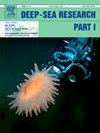An inverse modelling approach to constrain 7Be cycling in the subpolar North Atlantic
IF 2.1
3区 地球科学
Q2 OCEANOGRAPHY
Deep-Sea Research Part I-Oceanographic Research Papers
Pub Date : 2025-02-17
DOI:10.1016/j.dsr.2025.104465
引用次数: 0
Abstract
Beryllium-7 is a short-lived cosmogenic radionuclide that has been used as a tracer of atmospheric deposition at the sea surface and of physical processes in the upper ocean. These applications generally assume that (i) the fraction of marine 7Be in particulate form is negligible, and/or (ii) the interactions between the particulate and dissolved forms of 7Be in seawater can be neglected. In this study, we test different steady-state models of upper ocean 7Be cycling from measurements of total 7Be and particulate 7Be activities collected at two stations of the GEOVIDE cruise in the subpolar North Atlantic (May–June 2014). The most complete model includes vertical advection, vertical diffusion, gravitational settling, radioactive decay, atmospheric deposition, and the reversible exchange between dissolved 7Be (7Bed) and particulate 7Be (7Bep). This model reproduces the measured 7Be activities at both stations to within their uncertainties (±1 standard deviation). In the East Greenland-Irminger Current (station 51/60), models that do not consider adsorption and/or desorption can still reproduce the measured activities, while in the southern Labrador Sea (station 69) models that neglect reversible exchange or desorption poorly fit the data. Thus, 7Bed at station 51/60 could have been supplied entirely by surface deposition, whereas 7Bed at station 69 originated at least partly from the release of particulate 7Be into solution. The subsurface 7Bep maxima, present at both stations, seem to require a flux of 7Be between particles and solution at station 69 but not at station 51/60. At both stations, most of the total 7Be deposited at the ocean surface was removed by radioactive decay, with at most 5% removed by sinking of 7Bep, suggesting that reversible exchange can be neglected in applications of total 7Be as a tracer for atmospheric deposition. However, reversible exchange is important to consider in applications of 7Bed as a deposition tracer, with a maximum bias of 40% when reversible exchange is neglected. The steady state assumption does not alter our results regarding the solid-solution exchange of 7Be, but it does result in a significant bias when deriving atmospheric 7Betot deposition fluxes from water column 7Betot inventories. Overall, our findings suggest that reversible exchange could significantly influence the oceanic cycling of 7Be at some locations, and should not be systematically neglected when using 7Bed as an oceanic tracer.
约束北大西洋次极地7Be循环的逆模拟方法
铍-7是一种短寿命的宇宙生成放射性核素,已被用作海洋表面大气沉积和海洋上层物理过程的示踪剂。这些应用通常假设(i)海洋中颗粒形式的7Be的比例可以忽略不计,和/或(ii)海水中颗粒形式和溶解形式的7Be之间的相互作用可以忽略。在这项研究中,我们从2014年5月至6月在北大西洋亚极地GEOVIDE巡航的两个站点收集的总7Be和颗粒7Be活动测量数据中测试了不同的上层海洋7Be循环稳态模型。最完整的模型包括垂直平流、垂直扩散、重力沉降、放射性衰变、大气沉降以及溶解态7Be (7Bed)与颗粒态7Be (7Bep)之间的可逆交换。该模型再现了两个站点测量到的7Be活动,其不确定度(±1个标准差)。在东格陵兰-伊明格海流(51/60站),不考虑吸附和/或解吸的模式仍然可以重现测量到的活动,而在拉布拉多海南部(69站),忽略可逆交换或解吸的模式对数据的拟合很差。因此,51/60站的7Bed可能完全由地表沉积提供,而69站的7Bed至少部分来自颗粒7Be释放到溶液中。两个站点的地下7Bep最大值似乎要求69站点的粒子和溶液之间的7Bep通量,而51/60站点则不需要。在这两个站点,沉积在海洋表面的大部分7Be被放射性衰变去除,7Bep沉降最多去除5%,这表明在总7Be作为大气沉积示踪剂的应用中,可逆交换可以忽略不计。然而,在7Bed作为沉积示踪剂的应用中,可逆交换是很重要的,当忽略可逆交换时,最大偏差为40%。稳态假设不会改变我们关于7Be固溶交换的结果,但在从水柱7Betot库存中得出大气7Betot沉积通量时,它确实会导致明显的偏差。总的来说,我们的研究结果表明,可逆交换可以显著影响7Be在某些位置的海洋循环,当使用7Bed作为海洋示踪剂时,不应系统地忽略这一点。
本文章由计算机程序翻译,如有差异,请以英文原文为准。
求助全文
约1分钟内获得全文
求助全文
来源期刊
CiteScore
4.60
自引率
4.20%
发文量
144
审稿时长
18.3 weeks
期刊介绍:
Deep-Sea Research Part I: Oceanographic Research Papers is devoted to the publication of the results of original scientific research, including theoretical work of evident oceanographic applicability; and the solution of instrumental or methodological problems with evidence of successful use. The journal is distinguished by its interdisciplinary nature and its breadth, covering the geological, physical, chemical and biological aspects of the ocean and its boundaries with the sea floor and the atmosphere. In addition to regular "Research Papers" and "Instruments and Methods" papers, briefer communications may be published as "Notes". Supplemental matter, such as extensive data tables or graphs and multimedia content, may be published as electronic appendices.

 求助内容:
求助内容: 应助结果提醒方式:
应助结果提醒方式:


